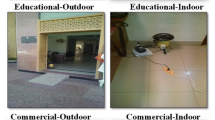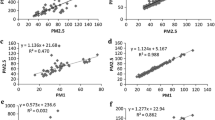Abstract
Fine particles are recognized as one of the main air pollutants that could give negative effects on human health and air quality status. Increase in amount of industrial activities and vehicle could enhance the number of possible sources of PM2.5. This may increase the concentration of PM2.5 for both ambient and inside the building including school. Morphological properties and elemental composition are two components that role significantly in determination of potential sources of particulate matter. Thus, in this research, physical characteristic and elemental component for indoor and outdoor PM2.5 was determined by using Field Emission Scanning Electron Microscopy coupled with energy dispersive X-ray (FESEM-EDX). Results show that there is significant (p < 0.05) relationship between indoor and outdoor PM2.5 concentrations at this selected school with correlation coefficients, r = 0.376. For the morphology and elemental composition analysis, it shows that there are similar shapes of indoor and ambient PM2.5 which irregular shaped and transition metal particles. For the elemental components, range for indoor elements of PM2.5 is O > Si > Ca > C > Na > Mg > Al > Cl and for outdoor PM2.5, the range is O > Si > Na > Ca > Ba > Al > Mg > K > Cl. Therefore, effect of outdoor towards indoor PM2.5 had been significantly identified in this school classroom.
Access this chapter
Tax calculation will be finalised at checkout
Purchases are for personal use only
Similar content being viewed by others
References
Adachi K, Chung SH, Buseck PR (2010) Shapes of soot aerosol particles and imply cations for their effects on climate. J Geophys Res 115:D15206
American Society of Heating, Refrigerating and Air-Conditioning Engineers (ASHRAE) (2007) Ventilation for acceptable indoor air quality. ASHRAE Standard 62.1, pp 25–27
Department of Environment Malaysia (DOE) (2014) Malaysia ambient air quality standard online on 12th July 2019
Dockery WD, Pope CA, Xu X, Spengler JD, Ware JH, Fay ME, Ferris BGJ, Speizer FE (1993) An association between air pollution and mortality in six U.S. cities. New Engl J Med 329:1753–1759
Dominick D, Latif MT, Juahir H, Aris AZ, Zain SM (2012) An assessment of influence of meteorological factors on PM10 and NO2 at selected stations in Malaysia. Sustain Environ Res 22(5):305–312
Duong HT, Sorooshian A, Craven JS, Hersey SP, Metcalf AR, Zhang X, Weber RJ, Jonsson H, Flagan RC, Seinfeld JH (2011) Water-soluble organic aerosol in the Los Angeles Basin and outflow regions: airborne and ground measurements during the 2010 CalNex field campaign. J Geophys Res 116:D00V04
Ghio AJ, Devlin RB (2001) Inflammatory lung injury after bronchial installation of air pollution particles. Am J Respir Crit Care Med 164:704–708
Guildford JP (1973) Fundamental statistics in psychology and education, 5th edn. McGraw-Hill, New York
Hassanvand MS, Naddafi K, Faridi S, Arhami M, Nabizadeh R, Sowlat MH, Pourpak Z, Rastkari N, Momeniha F, Kashani H, Gholampour A, Nazmara S, Alimohammadi M, Goudarzi G, Yunesian M (2014) Indoor/outdoor relationships of PM10, PM2.5 and PM1 mass concentrations and their water-soluble ions in a retirement home and a school dormitory. Atmos Environ 82:375–382
Jan R, Roy R, Yadav S, Satsangi PG (2017) Exposure assessment of children to particulate matter and gaseous species in school environments of Pune, India. Build Environ 111:207–217
Maskey S, Chae H, Lee K, Nguyen PD, Khoi TT, Park K (2016) Morphological and elemental properties of urban aerosols among PM events and different traffic systems. J Hazard Mater 317:108–118
Mohammadyan M, Alizadeh-Larimi A, Etemadinejad S, Latif MT, Heibati B, Yetilmezsoy K, Abdul-Wahab SA, Dadvand P (2017) Particulate air pollution at schools: indoor–outdoor relationship and determinants of indoor concentrations. Aerosol Air Qual Res 17:857–864
Monsalve MS, Martínez L, Vásquez KY, Orellana SA, Vergara JK, Mateo MM, Salazar RC, Alburquenque MF, Lillo CDD (2017) Trace element contents in fine particulate matter (PM2.5) in urban school microenvironments near a contaminated beach with mine tailings, Chañaral, Chile. Environ Geochem Health 40(3):1077–1091
Othman M, Latif MT, Matsumi Y (2019) The exposure of children to PM2.5 and dust in indoor and outdoor school classrooms in Kuala Lumpur city center. Ecotoxicol Environ Saf 170:739–749
Parallés S, Gómez ET, Jordán MM (2019) Typological characterization of mineral and combustion airborne particles indoor in primary school. Atmosphere 10(209):1–16
Pope CA III, Dockery WD (2006) Health effects of fine particulate air pollution: lines that connect. J Air Waste Manag Assoc 56:709–742
Salma I, Maenhaut W, Zemplén-Papp E, Záray G (2001) Comprehensive characterization of atmospheric aerosols in Budapest, Hungary: physicochemical properties of inorganic species. Atmos Environ 35:4367–4378
Shahid MAK, Awan MS, Hussain K, Sabir R (2013) Scanning and transmission electron microscopical and dynamical characterization of soot coated solid aerosols peak. J Air Waste Manag Assoc 46:927–939
Shi Y, Ji Y, Sun H, Hui F, Hu J, Wu Y, Lanza M (2015) Nanoscale characterization of PM2.5 airborne pollutants reveals high adhesive and aggregation capability of soot particles. Sci Rep 5(4)
Smith KR, Woodward A, Campbell-Lendrum D, Chadee DD, Honda Y, Liu Q, Olwoch JM, Revich B, Sauerborn R (2014) Human health: impacts, adaptation, and co-benefits. In: Field CB, Barros VR, Dokken DJ, Mach KJ, Mastrandrea MD, Bilir TE, Chatterjee M, Ebi KL, Estrada YO, Genova RC, Girma B, Kissel ES, Levy AN, MacCracken S, Mastrandrea PR, White LL (eds) Climate change 2014: impacts, adaptation, and vulnerability. Part A: Global and sectoral aspects. Contribution of Working Group II to the fifth assessment report of the intergovernmental panel on climate change. Cambridge University Press, Cambridge, United Kingdom and New York, NY, USA, pp 709–754
Tasić M, Durić-Stanojević B, Rajšić S, Mijić Z, Novaković V (2006) Physico-chemical characterization of PM10 and PM2.5 in the Belgrade urban area. Acta Chim Slov 53:401–405
van der Zee SC, Strak M, Dijkema MBA, Brunekreef B, Janssen NAH (2016) The impact of particle filtration on indoor air quality in a classroom near a highway. Indoor Air 27:291–302
Wichmann J, Lind T, Nilsson MM, Bellander T (2010) PM2.5, soot and NO2 indoor–outdoor relationships at homes, pre-schools and schools in Stockholm, Sweden. Atmos Environ 44:4536–4544
Zhang R, Liu C, Zhou G, Jie S, Liu N, Hsu PC, Wang H, Qiu Y, Zhoa J, Wu T, Zhao W, Yi C (2018) Morphology and property investigation of primary particulate matter particles from different sources. Nano Res 11(6):3182–3192
Acknowledgements
The authors would like to acknowledge the Ministry of High Education (Malaysia) for Fundamental Research Grant Scheme (FRGS) 203.PAWAM.6071360 and RUI USM Grant Scheme 1001.PAWAM.8014106 throughout this research.
Author information
Authors and Affiliations
Corresponding author
Editor information
Editors and Affiliations
Rights and permissions
Copyright information
© 2020 Springer Nature Switzerland AG
About this paper
Cite this paper
Suroto, A., Md. Yusof, N.F.F., Ramli, N.A., Shith, S. (2020). Morphology and Elemental Component of PM2.5 at a School Located Near Industrial Area in Malaysia. In: Mohamed Nazri, F. (eds) Proceedings of AICCE'19. AICCE 2019. Lecture Notes in Civil Engineering, vol 53. Springer, Cham. https://doi.org/10.1007/978-3-030-32816-0_121
Download citation
DOI: https://doi.org/10.1007/978-3-030-32816-0_121
Published:
Publisher Name: Springer, Cham
Print ISBN: 978-3-030-32815-3
Online ISBN: 978-3-030-32816-0
eBook Packages: EngineeringEngineering (R0)




